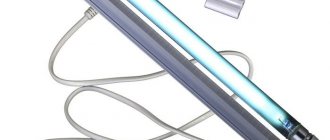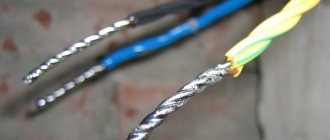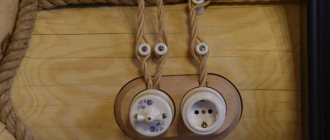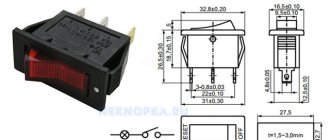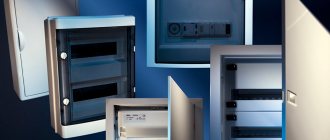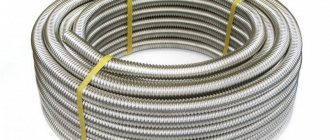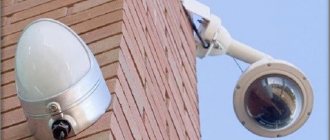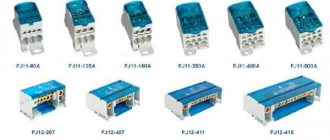As is known, the power supply system for the end consumer is built according to the schemes recommended by the Electrical Installation Rules (PUE). A power cable is supplied to the facility, and further wiring occurs in the distribution panel. For ease of installation and organization of power supply lines, inputs with different values are combined into contact groups. A bus with a phase, a zero bus is a contact block in which there is the ability to reliably connect several conductors to power electrical installations.
Requirements for the zero bus
- For a group network, the bus must be a single conductor, without the possibility of switching between its parts.
- The resistance should be the same along the entire length.
- Within one group line, it is allowed to combine conductors PE (protective grounding) and N (working zero).
In this case, after dividing the PEN input into PE and N buses, end consumers are connected to different buses.Important! Using one bus to connect the working zero and grounding is prohibited! This is a fundamental issue, it is necessary to understand the difference between splitting and merging PE and N.
From the moment of separation, the ground and neutral lines can be laid in one power cable, but the conductors must be insulated.
- Regardless of the connection method (three-phase or single-phase), the cross-section of the neutral conductor must correspond to the cross-section of any of the phase conductors. The same requirement applies to the cross-section of the tire itself.
- The cross-section of the connecting wires from the bus to the final electrical installation cannot be higher than the cross-section of the input power wire.
- If the bus is a structure with holes for connecting conductors, the actual cross-section is considered to be the geometric parameters in the thinnest part.
- There are no requirements for the mandatory production of a zero working tire from a specific metal. However, in practice, copper or brass is used. When calculating the cross-section of aluminum busbars in relation to copper busbars, a coefficient of 1.52 is applied.
For convenience, we will consider a single-phase circuit, which is used in most apartments in multi-storey buildings. Two main lines: phase and zero, are always present. They are inserted into the meter (electricity meter), and at the output they become available for further wiring. Depending on the system used, either only a zero bus or a zero and ground bus can be installed.
Features of Tire N, PE in automatic
In the N, PE bus, or more precisely in its design, it is possible to individually disconnect the conductors that are connected to it. But they can only be disconnected if you use a special tool.
The bus conductivity N, PE iek corresponds to the calculated operating current.
The N, PE iek busbar can only be installed openly if it is located in a location that can only be accessed by qualified personnel.
And if the tire is installed in places that may be accessible to strangers, then it must be protected. That is, there must be a closet with a door that can be locked with a key.
The N, PE bus is part of the grounding device of the electrical installation.
Purpose of bus N, PE iek
It is designed to connect several conductors. Purpose: to ground and equalize potentials in electrical installations located in buildings that connect different conductive parts.
- grounding conductor, which is connected to an artificial or natural grounding conductor;
— parts of air conditioning, as well as centralized ventilation systems;
Bus N, PE iek has direct contact (electrical) with the housing of the distribution cabinet.
They buy N, PE iek tires for switchboard rooms located in residential buildings.
What kind of lighting do you prefer?
Built-in Chandelier
They are used in the production of switchboard equipment to connect neutral working conductors, as well as protection grounding conductors.
They are necessary for mechanical and electrical connections, zero working and protective conductors.
Expert opinion
It-Technology, Electrical power and electronics specialist
Ask questions to the “Specialist for modernization of energy generation systems”
Buy a set of N and PE busbars for PR (gauge 2) IEK YKM10-NP-02 wholesale, price Upon closer examination of the design, you will notice that it consists of a conductive core and a base made of plastic, which is intended for installation on a DIN rail . Ask, I'm in touch!
Secrets and standards of installation
When installing the zero bus, one of several possible types of installation can be used (the appropriate one is prescribed in the instructions):
- On an insulator, screwed in the center or along the edges;
- Screw;
- On DIN rail;
- On G-rail.
In turn, zero bus insulators can be absent or can be case-type, “rack” type, combined, single or double corner (“leg” type).
Installation can also be closed (for example, for powerful or important equipment, to exclude the possibility of malicious damage to the tire) and open (when there is no risk of hacking or damage to the unit).
Below are detailed instructions on how to connect the zero bus, accompanied by step-by-step photographs:
- SIP wires: types, differences from cable, features and advantages
What is a Power Cable?
- How to conveniently unwind a cable coil on site during electrical installation
- Familiarize yourself with the appropriate panel connection diagram, find the zero bus in the image (the icon repeats the general appearance of the device marked “N”).
- De-energize the electrical panel by unscrewing all existing plugs or placing the circuit breakers in the inoperative position.
- Check that there is no voltage by holding an indicator screwdriver or multimeter to the input conductors.
- Determine the location for placing the bus depending on its design features (if fixation to special strips is provided, then install the necessary ones in the panel; if not, fasten them through insulators to a free place).
- Install the strip on the DIN or G using special clamps, or directly into the panel using a screw type of installation from the center or sides (where the insulator is located).
- Check the reliability of the fastenings by trying to “loose” the installed structure.
- Connect the conductor coming from the residual current device to one of the busbar clamping bolts.
- If the circuit has two or more protective connection devices, then each of them is connected in series to the bus.
- Connect the neutral conductors coming from the circuit breakers of each branch of the network to the corresponding terminal of the neutral protective device.
- Connect the common “zero” of the network to the outer terminal on the zero bus.
- Check the correctness and quality of all connections made.
- Turn on the electricity supply.
During work, it is important to follow the safety rules:
- Install only when there is no current in the conductors;
- Use special clamps, terminals, and not homemade “twists”;
- Ensure good contact of the wires, if necessary, trim and strip their ends;
- Do not allow wires to overlap, twist, break or bend;
- Do not neglect marking conductors in any available way (color, signature, signs).
The zero line is an integral part of any electrical network, so it is important to properly organize its functioning inside the panel. The zero bus will provide order and the possibility of sequential connection of all contacts to ensure safe, comfortable and complete use of electricity.
Why is it necessary to divide the PEN conductor into PE and N
Neutral is a neutral protective conductor that connects the neutrals of electrical installations in three-phase electric networks. Area of use: grounding electrical installations.
The PUE states: the place where the PEN conductor is separated must have appropriate distribution elements (busbars). The intersection of the working and protective zeros is not allowed. The main PEN conductor is connected to a place that will subsequently be mounted as a PE conductor.
The jumper can be either a wire with a cross-section of at least 10 cm², or a plate made of the same material as the busbars. In this case, an insulator must be installed between the working zero bus and the shield body. The grounding bus can be attached directly to the shield.
After such installation, according to the PUE, the protective bus should be re-grounded. For this purpose, the rules suggest using natural grounding conductors. After carrying out the work, you should check the resistance of the mounted grounding device and connect it to the bus.
Expert opinion
It-Technology, Electrical power and electronics specialist
Ask questions to the “Specialist for modernization of energy generation systems”
Why do you need a zero bus in the panel and how to connect it? If there is no switching device or circuit breaker at the input, then using the release bus makes no sense, since it creates unnecessary bolted connections where the contact may deteriorate. Ask, I'm in touch!
Installation Rules
Installation of the NS is possible both on a special rail and in an electrical panel. Installation options are available in both closed and open ways. The open method is perfect for a cabinet that will be closed to unauthorized persons. The closed version is used in situations where equipment is used that is connected to very important elements. An example is a power socket for various electrical tools.
The video below clearly shows how to install the NS on a DIN rail and how to fix it more reliably:
So we looked at the structure and purpose of the zero bus. We hope the information was useful and interesting for you!
You probably don't know:
- What is GZSh in electrical engineering?
- Why do you need a cross module?
- What is the danger of a broken neutral wire?
Material taken from the site:https://samelectrik.ru/
Types of artificial grounding systems
In the classification of grounding systems there are natural and artificial types of grounding.
- T - grounding;
- N - connection of the conductor to the neutral;
- I - insulation;
- C - combination of functional and neutral wire options;
- S - separate use of wires.
Many people are interested in the question of what is called working grounding. In another way it is called functional. The answer to this question is given by paragraph 1.7.30 of the PUE. This is the grounding of points of live parts of an electrical installation. It is used to ensure the functioning of electrical devices or installations, and not for protective purposes.
Also, many are concerned about the question of what protective grounding is. This is the process of grounding devices to ensure electrical safety.
Benefits of using busbar trunking
An electrical bus is more convenient to use than a group of wires
The use of busbars in electrics instead of cable products provides significant savings in material, energy and labor resources:
- Installation takes 2 times less time than cable laying.
- Service life – up to 30 years without the need for complex maintenance.
- The flexible configuration allows for high-quality and safe installation of the network, depending on the route it runs.
- The busbar has a more aesthetic appearance than group wiring.
- Shielding the conductor eliminates the impact of the electromagnetic field on nearby office equipment.
- The design is fireproof and meets safety requirements for IP55 protection level.
Design of the grounding bus
The grounding bus of a private house is installed in a separate cabinet (photo) or in a water distribution device along with circuit breakers and protection devices.
If a separate input device (IDU) or IDU is installed on a pole before the ASU (input switchgear), which is located in the house, then the grounding bus is installed in it. At the same time, do not forget about re-grounding the PEN conductor outside the shield on the pole. The grounding bus on the pole is connected to the main shield in the house panel.
Usually the GZSh is a copper plate with holes. The grounding wires are pre-crimped with a cable lug or connecting sleeve. The wires are connected to the main frame with a bolt and nut. Grounding wires are marked.
The grounding bus must have conductive contact with the housings of the VU or ASU.
There is no need to confuse the GZSh and the PE conductor bus. Although they are connected to each other electrically, these are two different buses. The PEN conductor is connected to the PE bus from the overhead line post, where it is divided into PE (zero protective) and N (zero working) conductors. The following figure clearly shows this.
Let's look at the installation of the main grounding bus using examples.
Articles on the topic: Introductory installation of a private house, cottage, dacha
Which manufacturer to choose
In fact, preference for one logo over another is not related to quality. Accessories for installing electrical wiring are produced by all well-known electrical companies. And if your entire socket network, circuit breakers and wiring are manufactured by IEK, ABB, Legrand or Schneider Elerctric, it makes sense to buy zero rails and protective earth buses with the same logo.
Extremely cheap “noname” products can simply crack during operation, causing guaranteed problems for expensive electrical equipment.
Purpose
The use of a zero bus makes it possible to solve several very important problems:
- First of all, you can create several points at once to connect loads from the common input to a zero-type conductor.
- Conduct visible grounding using a device with a cover made of transparent material that covers the terminals.
- Significantly improve the effective use of automatic protective devices.
- Ensure continuity of the circuit in the area from grounding to a specific load.
- Fulfill an important condition, which involves separating the wires of the neutral (protective) and working types. We talked about how to split a PEN conductor in a separate article.
Expert opinion
It-Technology, Electrical power and electronics specialist
Ask questions to the “Specialist for modernization of energy generation systems”
The review will not be published if: That’s all I wanted to tell you about where the division of the PEN conductor into PE and N should be done according to the rules of the PUE. Ask, I'm in touch!
Characteristics
Now very clear requirements have been established for the selection of zero tires. The most important rule is not to exceed the wire cross-section of a similar indicator in the GZSh. So that you understand, it is possible to insert from one to four dozen wires into the box. For example, for the 3 by 40 option, a wire is provided, the cross-section of which reaches 3 millimeters with a maximum allowable connection of four dozen.
As for the technical specifications, we have provided some of the parameters in the table below. Each manufacturer has its own design features and characteristics of zero tires. For example, we took IEK products:
PUE safety requirements
The power supply system is ideally compiled according to the circuits recommended by the electrical installation rules (PUE). A power cable is connected to a residential premises or to a separate facility, and its subsequent wiring inside the building is provided using a distribution panel.
For the convenience of such wiring, a zero bus is used. Simply put, such a device is a reinforced open-type conductor in the contact zone. Neutral conductors are connected to it using screw connectors.
A common bus design is a rectangular bar made of durable metal with characteristic conductivity: brass, copper alloys.
What is color coding of tires and wires and why is it needed?
Nowadays, electrical wiring is carried out using wires with different insulation colors. And the point here is not about some fashion trends or the beauty of the product itself, but about the safety and ease of use of this electrical wiring.
After all, colored insulation can perform two functions simultaneously - protection against electric shock or protection against short circuits by applying insulating material to the conductor, and with the help of the color of this very insulating material, it helps the electrician determine the purpose of this conductor.
To avoid confusion, all color colors were reduced to a single standard, described in the PUE.
Color marking can be done both along the entire length of the conductor and at the connection points of the conductors or at their ends. To do this, colored electrical tape or heat-shrinkable tubes (cambrics) can be used.
In this article we will look at color marking in single-phase and three-phase circuits, as well as in DC circuits.
How to choose a housing for an electrical panel in an apartment or house
Since all the elements from the diagram are installed inside the panel body, it must be selected after developing the installation plan. So that everything you need will fit and there will be some reserve for adding components. The result is a diagram for 42 modules, which means we’ll take the case for 46, or we’ll take 66 places, and we’ll take the cabinet for 72.
The free space will allow you to connect a new line or pair if the need arises. For example, we bought more household appliances, but the cable and sockets in the kitchen/bathroom will not carry the overall load and we need to “throw in” additional ones. Or they changed the stove to a more powerful one and it needs a cable with different characteristics. Therefore, it is better to take a cabinet with a reserve number of modules than to later replace it with a new one and reassemble the entire panel.
When choosing a housing, the space available for connecting wires and connecting groups of machines is also taken into account. During installation, it is necessary to maintain a safe distance between elements. You cannot push them and the wires tightly, compacting them like sprat in a jar.
Metal cabinets are most often wall-mounted and mounted on the wall. They are available in both standard versions with a degree of protection IP 31-43, and moisture resistant with IP 44-54. To assemble a shield in a house or apartment, a standard housing is sufficient; it is unlikely to get exposed to rain or be placed next to water supply pipes. Sealed boxes are useful for installation outdoors and are not of interest to us. There are models of metal cabinets for installation in a niche; if you like metal and want to put the cabinet into the wall, choose this one.
Plastic panels are produced for both wall and niche installation. You can choose a plastic cabinet for small assemblies (in apartments/country houses) and for complex multi-component panels (cottage, country house, large apartment). In terms of strength and IP protection, they are not inferior to metal ones.
The number of modules is the number of elements the size of one module that can fit on the slats. If an element occupies more than one module in width, then fewer elements will fit into the housing. To determine the required number, you need to add up the dimensions of all the circuit elements in the modules, taking into account the margin for the distance between the parts.
Methods for converting a multi-storey building to the TN-CS system
It makes no sense to remodel the TN-C system of the entire house yourself; there are special services for this. Another question is when it will be time to overhaul the entire house.
Options for remodeling the electrical system of a multi-story building:
- As trivial as it may seem, many residents of multi-storey buildings prefer to just wait. Now in the country, at the federal level, there are programs to carry out major repairs. You can find out from the relevant authorities responsible for utilities whether the house is on the waiting list or not, and when repairs are planned.
- You don’t have to wait for major repairs, but pay for the services of a company that installs electrical networks. Of course, this method is very expensive, since the company lays new lines, installs grounding devices, and installs new electrical panels. But in addition to electrical installation work, the company also takes on the regulatory framework, which it then independently certifies to all authorities. Residents only have to pay for the services.
- There is a collaboration option. Residents offer a lower amount, but will actively help with the work. Unfortunately, not many companies agree to this option, preferring to do everything themselves.
If none of the above options suits you, then you can independently separate the PEN conductor in the electrical panel on the staircase. The costs will be much lower than when installing an entrance cabinet for an entire house. If you carry out the work yourself, you only need to purchase consumables, the prices of which are now moderate.
Form of conclusions
The most common are comb buses with pin taps (pin type combs). The English name is pin. They fit most modern circuit breakers. The terminals of such tires are more difficult to bend during transportation. Therefore, during installation there are fewer problems with installing circuit breakers into the holes.
The second type of bends is fork-shaped (fork type). They are used relatively less frequently. Not suitable for all types of modern equipment. Connecting bars with forked terminals are not recommended for use with powerful loads. Usually they are placed in a panel with a maximum current of up to 63 A.
Double-pole fork-shaped comb
Connecting single-phase devices
Single-phase connection is the simplest. It is used for single-pole machines. The procedure is as follows:
- All protection devices are installed in a row. This requires a DIN rail.
- For each individual device, the screws in the terminal blocks are loosened to a certain point. This is done from the top side.
- One single-pole bus is inserted into the terminal blocks of circuit breakers. The pitch of its teeth should be 17.5 mm.
- The screws are tightened. The tightening is tight enough to securely fix the tire pins.
Dangerous silence
The second difference is the engine noise, which is very quiet in the case of electric vehicles. Driving at low speeds, below 20-30 km/h, is virtually silent.
From July 2022 this will change as new electrics, i.e. warning noise, will be required to use the AVAS system. Older models must be equipped with this technology by July 1, 2021. Mandatory sound generators are intended primarily to make life easier for pedestrians and the blind.
However, AVAS (Acoustic Vehicle Alert System) will not change the fact that electric vehicles are quieter. Aerodynamic noise by itself does not mask the noise produced by a rolling tire, as engine noise would. The tire companies' response to comments about excessive noise was simple - noise level has quickly become one of the most important parameters of EV tires.
Varieties of combs
There is no universal connecting bus suitable for any circuit breaker. The machines have different dimensions, number of pins and other characteristics. Therefore, combs come in a wide variety.
Based on the shape of the contacts, there are 2 types of comb busbars:
- Pin (toothed). Universal contact suitable for any machine.
- Forked. Used where the tire needs to be clamped under screws.
The combs differ in length, that is, in the number of machines that can be connected to them. If necessary, a tire that is too long can be shortened with a hacksaw. But it is preferable to use products for a standard number of machines:
There are also differences in the number of connected phases. From this point of view, connecting busbars are of the following types:
- Per 1 pole (1P). Used to connect single-phase group circuit breakers.
- 2 poles (2P). RCDs, automatic circuit breakers and any other devices that require a phase and zero connection.
- 3 poles (3P). Used to connect three-phase group circuit breakers.
- 4 poles (4P+N). Three-phase machines and devices that require a neutral wire to operate (three-phase RCDs).
Pin connection bus for three-phase network
Important! If you had to cut one large tire into several small ones, then you need to pay attention to the resulting cut. Individual conductors must not be bent or shorted together. After cutting, you need to remove copper dust from the comb.
Design
Before you figure out how to connect the zero bus, you should take a closer look at the design characteristics of the element being described. The zero bus is presented in the form of a core responsible for conducting current; its base is made of plastic and is used for installation on a DIN strip.
The current-carrying core contains recesses and clamp-type bolts; they are used to fix the bus conductors, and also provide high-quality internal wiring of the distribution device.
The described tires differ from each other in the following elements:
- presence and absence of the body;
- number of installation holes;
- length.
In more detail, the design of the zero tire can be found in the photo.

